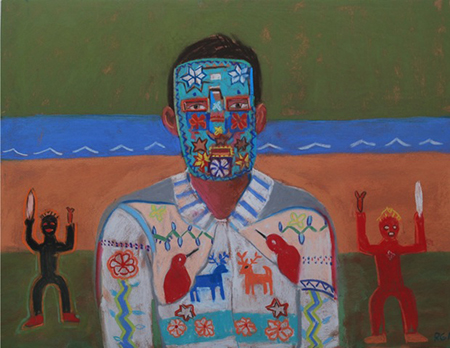
Continuing through May 10, 2014
The title of Roberto Gil De Monte’s current exhibition, "Hecho en México" translates to Made in Mexico. This indicates the influence and permanence that a culture inscribes on its inhabitants even long after they have left. Born and raised in Guadalajara, Gil de Montes moved to Los Angeles in 1965 but his developing practice as a sculptor, photographer and painter remained shaped by his early impressions of Orozco murals, the zeitgeist of Frida Kahlo and Diego Rivera, and the symbolism of the Pre-Columbian era. The influence of large-scale murals is felt in viewing "Hecho en México," where an arsenal of symbols rendered in a flattened manner similar to hieroglyphics is repeated from one painting to the next, steadily unfolding a narrative of religion, ritual, history and the dichotomous nature of the self.
For Gil De Montes this new body of work celebrates the juxtaposition of his roots in Mexico combined with the influence and mystery of the graffiti strewn throughout his neighborhood in Echo Park. The tapestry that the artist weaves with symbols is echoed in his thoughtful manipulation of the paint when applied to like canvas, linen and sandpaper. As a multi-disciplinary artist, Gil De Montes’ work appears sculptural in the intricate details, photographic in the deliberate flatness of the subjects and painterly in the application of the medium.
The Day of the Dead honors the memory of loved ones past with ornate skulls. In "Yo Cora," which translates to “I Heart,” we are presented with the bust of a man who displays an unflinching and piercing gaze. His face is covered with a blue mask that is symmetrically adorned with white flowers above the eyebrow and red ones below that resemble bloody tears. The flowers create various expressions that can be mistaken for a smile or a frown. The man wears a decorated garb that receives equal attention to details that include hummingbirds, deer and lighting bolts stemming from a budding flower. Behind the figure are two warriors with both arms held high and ready to attack. Their presence suggests a dichotomous battle of good and evil, heaven and hell or the past and present.
The same mask reappears in three other works: "Monster Wins,” “Wixáritari" and "Angel y Paloma." It is surrounded by a cyclonic composition of flora, wide-eyed owls, human skeletons, underwater creatures and lighting bolts. In "Monster Wins" four black birds gather near a fallen shovel and leaning ladder suggesting impending doom. Featured prominently in many works is a revolver with a single red stain expelled from the barrel. What does the mask represent? Is it unique to the artist’s family and one that he would decorate for the Day of the Dead? The metaphorical implication is that the artist wears a mask while defining his practice, hiding who he truly is. If he provides us with signs that suggest his presence and the marks his native Guadalajara has left on him, so too does his visage leave its own mark on "Hecho en México."
